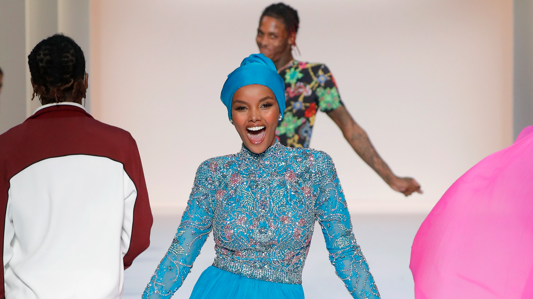
"I opened the door to an industry that never was for us. I feel I have opened the door to the lion’s mouth."
Halima Aden was born in a refugee camp, then became a catwalk star and a Unicef ambassador — and walked away from both. She explains why.
thetimes.co.uk/article/i-wore…
Halima Aden was born in a refugee camp, then became a catwalk star and a Unicef ambassador — and walked away from both. She explains why.
thetimes.co.uk/article/i-wore…
Has the first woman to wear a hijab on the cover of Vogue fallen out of love with fashion?
She flashes a look suggesting that’s not even the half of it. “Oh, just a little bit,” she says.
She flashes a look suggesting that’s not even the half of it. “Oh, just a little bit,” she says.
For four years she was fashion’s darling of diversity. When she was an unknown 19-year-old, her contract stipulated a private dressing space at shows and no male stylists.
Modesty was a must, the hijab non-negotiable. Sticking to her guns, she shot to the top. Then she quit.
Modesty was a must, the hijab non-negotiable. Sticking to her guns, she shot to the top. Then she quit.

Halima wants to warn those who might follow in her footsteps about how exploitative the fashion world can be.
“I opened the door to an industry that never was for us. So I also have to be the person who is going to speak up.”
“I opened the door to an industry that never was for us. So I also have to be the person who is going to speak up.”

“I’d never known of an industry with so many desperate people in it, who were willing to do anything under the moon to be there.
I think it’s very sad because automatically you lose all your power when you get desperate.’’
I think it’s very sad because automatically you lose all your power when you get desperate.’’
She started allowing the stylists to style her hijab. It seemed to shrink with every shoot. “People were asking me, ‘Where is the hijab? It’s no longer even visible.'"
“Despite me saying, ‘Don’t change yourself, change the game’, that was exactly what I was doing.” One “horrendous” magazine cover she regrets made her look like a “white man’s fetishised version of me”.
“I’m not saying it’s not right for other Muslim, hijab-wearing women, I’m saying it was not right for me. I felt like one of the biggest tokens in the industry. I always felt like an outsider in my own career.” 

Yet turning her back on the catwalk was easy compared with quitting her role as an ambassador for Unicef, the charity that supports tens of thousands of children in the Kenyan refugee camp where she was born.
Before she became a model, images of Halima as an impoverished child — “from a baby until I was seven” — were used to promote the work of NGOs. Her first headshots, she says, were for Unicef. 

She recalled how the NGOs “would bring various celebrities back to the camp and we danced for the visitors. I asked the kids, ‘Are they still making you dance for the visitors?’ They said, ‘Yes, but this time we’re doing it for you.’ That broke my heart.”
The more she speaks, the more tearful she becomes. “I cried on the flight all the way home. I spent that whole trip crying. There was a lot of survivor’s guilt.”
She had taken on the role, she insists, because as a former refugee she believed she would be “more relatable than other ambassadors like Selena Gomez”, but the double standards hit home.
Read the full interview here: thetimes.co.uk/article/i-wore…
Read the full interview here: thetimes.co.uk/article/i-wore…
• • •
Missing some Tweet in this thread? You can try to
force a refresh





